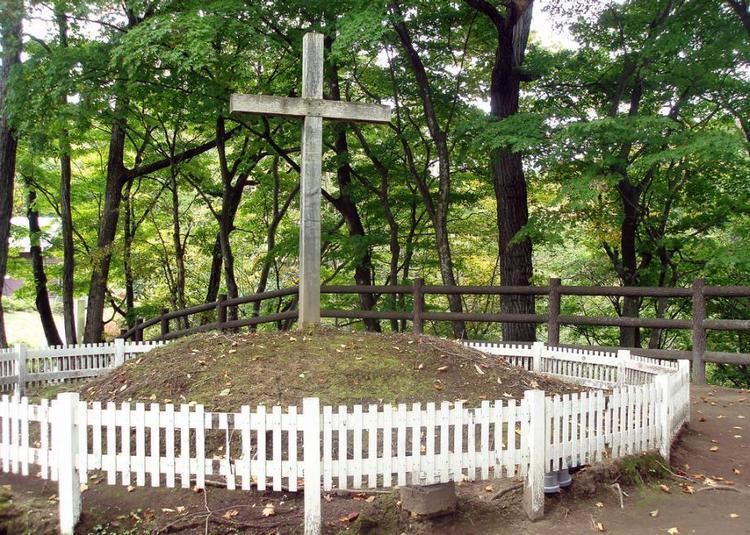District Sannohe - Flower Asian skunk cabbage Local time Sunday 1:27 AM | - Tree Aesculus Area 150.8 km² Population 2,495 (Oct 2016) | |
 | ||
Weather -2°C, Wind SW at 3 km/h, 93% Humidity | ||
Shingō (新郷村, Shingō-mura) is a village located in Sannohe District of south-central Aomori Prefecture in the Tōhoku region of Japan. As of 1 October 2016, the village has an estimated population of 2,495 and a population density of 16.5 persons per km². Its total area is 150.77 square kilometres (58.21 sq mi). The village promotes itself as the home of the Grave of Christ (キリストの墓, Kirisuto no Haka) after a local legend.
Contents
- Map of Shingo Sannohe District Aomori Prefecture Japan
- Geography
- Neighbouring municipalities
- Demographics
- History
- Education
- Economy
- Railway
- Highway
- Tomb of Jesus Christ
- References
Map of Shingo, Sannohe District, Aomori Prefecture, Japan
Geography
Shingō is in south-central Aomori Prefecture, east of Lake Towada. Much of the village is mountainous, rising to over 1000 meters in altitude near the border with Akita Prefecture. The village has a cold Humid continental climate characterized by cool short summers and long cold winters with very heavy snowfall (Köppen climate classification Dfa). The average annual temperature in Shingō is 8.7 °C. The average annual rainfall is 1342 mm with September as the wettest month.The temperatures are highest on average in August, at around 22.2 °C, and lowest in January, at around -3.7 °C.
Neighbouring municipalities
Aomori Prefecture
Demographics
Per Japanese census data, the population of Shingō has declined over the past 40 years.
History
The area around Shingō was controlled by the Nambu clan of Morioka Domain during the Edo period. During the post-Meiji restoration cadastral reform of April 1, 1889, Herai Village and neighboring Nozawa Village were formed. On July 29, 1955 the western portion of Nozawa Village merged into Herai, which was then renamed Shingō.
Education
Shingō has two public elementary schools and two public middle schools operated by the village government. The village does not have a high school.
Economy
The economy of Shingō is heavily dependent on agriculture. Notable crops include edible chrysanthemum, Japanese yam and tobacco. Traditionally a horse breeding area, Shingō is also known for its cattle ranches.
Railway
Highway
Tomb of Jesus Christ
Shingō village is the location of what is purported to be the last resting place of Jesus, located in the "Tomb of Jesus" (Kirisuto no haka), and the residence of Jesus' last descendants, the family of Sajiro Sawaguchi. According to the Sawaguchi family's claims, Jesus Christ did not die on the cross at Golgotha. Instead his brother, Isukiri, took his place on the cross, while Jesus fled across Siberia to Mutsu Province, in northern Japan. Once in Japan, he became a rice farmer, married, and raised a family with three daughters near what is now Shingō. While in Japan, it is asserted that he traveled, learned, and eventually died at the age of 106. His body was exposed on a hilltop for four years. According to the customs of the time, Jesus' bones were collected, bundled, and buried in the mound purported to be the grave of Jesus Christ.
Another mound near the alleged grave of Jesus is said to contain an ear of the brother of Jesus and a lock of hair from Mary, the mother of Jesus, the only relics of his family Jesus could carry when he fled Judaea. The claims started in 1933 after the discovery of supposed "ancient Hebrew documents detailing Jesus' life and death in Japan" that was supposedly the testament of Jesus. These documents were allegedly seized by the Japanese authorities and taken to Tokyo shortly before World War II and have not been seen since.
The English text on the sign explaining the legend of the Tomb of Christ reads:
When Jesus Christ was 21 years old, he came to Japan and pursued knowledge of divinity for 12 years. He went back to Judea at age 33 and engaged in his mission. However, at that time, people in Judea would not accept Christ's preaching. Instead, they arrested him and tried to crucify him on a cross. His younger brother, Isukiri casually took Christ's place and ended his life on the cross.
Christ, who escaped the crucifixion, went through the ups and downs of travel, and again came to Japan. He settled right here in what is now called Herai Village, and died at the age of 106.
On this holy ground, there is dedicated a burial mound on the right to deify Christ, and a grave on the left to deify Isukiri.
The above description was given in a testament by Jesus Christ.
